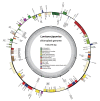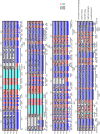Complete Chloroplast Genome of Medicinal Plant Lonicera japonica: Genome Rearrangement, Intron Gain and Loss, and Implications for Phylogenetic Studies
- PMID: 28178222
- PMCID: PMC6155926
- DOI: 10.3390/molecules22020249
Complete Chloroplast Genome of Medicinal Plant Lonicera japonica: Genome Rearrangement, Intron Gain and Loss, and Implications for Phylogenetic Studies
Abstract
The complete chloroplast (cp) genome of Lonicera japonica, a common ornamental and medicinal plant in North America and East Asia, was sequenced and analyzed. The length of the L. japonica cp genome is 155,078 bp, contains a pair of inverted repeat regions (IRa and IRb), of 23,774 bp each, as well as large (LSC, 88,858 bp) and small (SSC, 18,672 bp) single-copy regions. A total of 129 genes were identified in the cp genome, 16 of which were duplicated within the IR regions. Relative to other plant cp genomes, the L. japonica cp genome had a unique rearrangement between trnI-CAU and trnN-GUU. In L. japonica cpDNA, rps19, rpl2, and rpl23 move to the LSC region, from the IR region. The ycf1 pesudogene in the IR region is lost, and only one copy locates in the SSC region. Comparative cp DNA sequence analyses of L. japonica with other cp genomes reveal that the gene order, and the gene and intron contents, are slightly different. The introns in ycf2 and rps18 genes are found for the first time. Four genes (clpP, petB, petD, and rpl16) lost introns. However, its genome structure, GC content, and codon usage were similar to those of typical angiosperm cp genomes. All preferred synonymous codons were found to use codons ending with A/T. The AT-rich sequences were less abundant in the coding regions than in the non-coding ones. A phylogenetic analysis based on 71 protein-coding genes supported the idea that L. japonica is a sister of the Araliaceae species. This study identified unique characteristics of the L. japonica cp genome that contribute to our understanding of the cpDNA evolution. It offers valuable information for the phylogenetic and specific barcoding of this medicinal plant.
Keywords: Lonicera japonica; chloroplast genome; contraction.
Conflict of interest statement
The authors declare no conflict of interest.
Figures




References
-
- Wang J., Zhao X.Z., Qi Q., Tao L., Zhao Q., Mu R., Gu H.Y., Wang M., Feng X., Guo Q.L. Macranthoside B, a hederagenin saponin extracted from Lonicera macranthoides and its anti-tumor activities in vitro and in vivo. Food Chem. Toxicol. 2009;47:1716–1721. doi: 10.1016/j.fct.2009.04.034. - DOI - PubMed
-
- Li Y.M., Wang T.Z., Wang Z.X. Studies on chemical constituents in dried buds of Lonicera similis Hemsl. Zhongguo Zhong Yao Za Zhi. 2001;26:45–47. - PubMed
-
- Wang S.Y., Tseng C.P., Tsai K.C., Lin C.F., Wen C.Y., Tsay H.S., Sakamoto N., Tseng C.H., Cheng J.C. Bioactivity-guided screening identifies pheophytin a as a potent anti-hepatitis C virus compound from Lonicera hypoglauca Miq. Biochem. Biophys. Res. Commun. 2009;385:230–235. doi: 10.1016/j.bbrc.2009.05.043. - DOI - PubMed
MeSH terms
Substances
LinkOut - more resources
Full Text Sources
Other Literature Sources
Miscellaneous

